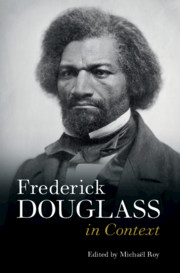Book contents
- Frederick Douglass in Context
- Frederick Douglass in Context
- Copyright page
- Contents
- Illustrations
- Contributors
- Chronology
- Abbreviations
- Introduction
- Part I Places
- Part II Genres
- Chapter 7 Autobiography
- Chapter 8 Oratory
- Chapter 9 Journalism
- Chapter 10 Fiction
- Chapter 11 Photography
- Part III Activism
- Part IV Philosophy
- Part V Networks
- Part VI Afterlives
- Further Reading
- Index
Chapter 10 - Fiction
from Part II - Genres
Published online by Cambridge University Press: 16 June 2021
- Frederick Douglass in Context
- Frederick Douglass in Context
- Copyright page
- Contents
- Illustrations
- Contributors
- Chronology
- Abbreviations
- Introduction
- Part I Places
- Part II Genres
- Chapter 7 Autobiography
- Chapter 8 Oratory
- Chapter 9 Journalism
- Chapter 10 Fiction
- Chapter 11 Photography
- Part III Activism
- Part IV Philosophy
- Part V Networks
- Part VI Afterlives
- Further Reading
- Index
Summary
In adapting his own speeches about the Creole rebellion, Frederick Douglass narrativized aspects of Madison Washington’s life to craft The Heroic Slave (1853). The novella, Douglass’s only foray into writing fiction, remains important for what it reveals about his shifting understanding of the relationship between aesthetics and politics as well as for what it illuminates about the arc of nineteenth-century African American literary history. With respect to his perspective on abolitionist politics in particular, Douglass used the occasion of writing The Heroic Slave to intimate a new position on physical violence and the right of revolution. With respect to African American literary history, The Heroic Slave marked a pivot towards the novel by a cadre of African American intellectuals in the years immediately before the Civil War.
Keywords
- Type
- Chapter
- Information
- Frederick Douglass in Context , pp. 121 - 132Publisher: Cambridge University PressPrint publication year: 2021

